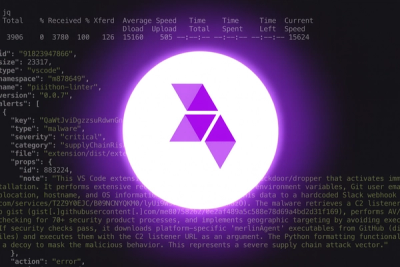
Product
Introducing Webhook Events for Alert Changes
Add real-time Socket webhook events to your workflows to automatically receive software supply chain alert changes in real time.
@fuuck/markdown-it-gladest
Advanced tools
[](https://www.npmjs.com/package/@fuuck/markdown-it-gladest) [](https://opensource.org/licenses/MIT)
A Markdown-it plugin to render LaTeX mathematical formulas using the Typst typesetting system. It leverages a high-performance native Rust addon to generate SVG or PNG images from your math blocks.
$ ... $) and block ($$ ... $$) LaTeX math.npm install markdown-it @fuuck/markdown-it-gladest
# or
yarn add markdown-it @fuuck/markdown-it-gladest
# or
bun add markdown-it @fuuck/markdown-it-gladest
Note: This package relies on a native Node.js addon built with Rust. Pre-compiled binaries for common platforms (Windows, macOS, Linux) are typically provided. If a pre-compiled binary is not available for your specific platform/architecture, you might need a Rust toolchain installed to build the addon during installation.
import { writeFileSync } from "node:fs";
import MarkdownIt from "markdown-it";
import markdownItGladest from "@fuuck/markdown-it-gladest";
// Initialize Markdown-it
const md = new MarkdownIt().use(markdownItGladest, {
// Plugin options (optional)
format: "svg", // 'svg' (default) or 'png'
ppi: 600, // Pixels Per Inch for PNG rendering (default: uses Typst default)
});
// Your Markdown content with LaTeX
const markdownContent = `
# Normal Distribution
The probability density function (PDF) is:
$$
f(x) = \\frac{1}{\\sigma\\sqrt{2\\pi}} e^{-\\frac{1}{2}\\left(\\frac{x-\\mu}{\\sigma}\\right)^2}
$$
Where $\\mu$ is the mean and $\\sigma$ is the standard deviation.
The standard normal distribution has $\\mu = 0$ and $\\sigma = 1$, denoted as $Z \\sim N(0,1)$.
An important transformation is standardization: $Z = \\frac{X-\\mu}{\\sigma}$.
`;
// Render the Markdown
const htmlResult = md.render(markdownContent);
// Save or use the result
writeFileSync("output.html", htmlResult);
console.log("Rendered HTML saved to output.html");
/*
Expected output in output.html (structure may vary slightly):
<h1>Normal Distribution</h1>
<p>The probability density function (PDF) is:</p>
<div class="gladst-block"><img src="data:image/svg+xml;base64,..." alt="f(x) = \\frac{1}{\\sigma\\sqrt{2\\pi}} e^{-\\frac{1}{2}\\left(\\frac{x-\\mu}{\\sigma}\\right)^2}" /></div>
<p>Where <span class="gladst-inline"><img src="data:image/svg+xml;base64,..." alt="\\mu" /></span> is the mean and <span class="gladst-inline"><img src="data:image/svg+xml;base64,..." alt="\\sigma" /></span> is the standard deviation.
The standard normal distribution has <span class="gladst-inline"><img src="data:image/svg+xml;base64,..." alt="\\mu = 0" /></span> and <span class="gladst-inline"><img src="data:image/svg+xml;base64,..." alt="\\sigma = 1" /></span>, denoted as <span class="gladst-inline"><img src="data:image/svg+xml;base64,..." alt="Z \\sim N(0,1)" /></span>.
An important transformation is standardization: <span class="gladst-inline"><img src="data:image/svg+xml;base64,..." alt="Z = \\frac{X-\\mu}{\\sigma}" /></span>.</p>
*/
You can customize fonts used for rendering mathematical formulas by specifying system fonts or font files:
import MarkdownIt from "markdown-it";
import markdownItGladest from "@fuuck/markdown-it-gladest";
const md = new MarkdownIt().use(markdownItGladest, {
format: "svg",
fonts: {
// Configure body font (used for text elements)
bodyFont: {
system: "Times New Roman",
},
// Configure math font (used for mathematical symbols)
mathFont: {
system: "Latin Modern Math",
},
},
});
import MarkdownIt from "markdown-it";
import markdownItGladest from "@fuuck/markdown-it-gladest";
const md = new MarkdownIt().use(markdownItGladest, {
format: "svg",
fonts: {
// Use custom font files
bodyFont: {
file: "/path/to/your/custom-font.ttf",
},
mathFont: {
file: "/path/to/your/math-font.otf",
},
},
});
import MarkdownIt from "markdown-it";
import markdownItGladest from "@fuuck/markdown-it-gladest";
const md = new MarkdownIt().use(markdownItGladest, {
format: "png",
ppi: 300,
fonts: {
// Use system font for body text
bodyFont: {
system: "Georgia",
},
// Use custom font file for math
mathFont: {
file: "/usr/share/fonts/opentype/lmodern/lmmath-regular.otf",
},
},
});
const content = `
Using custom fonts for better typography:
$$
\\sum_{i=1}^{n} \\frac{1}{i^2} = \\frac{\\pi^2}{6}
$$
The Euler's identity: $e^{i\\pi} + 1 = 0$.
`;
console.log(md.render(content));
You can pass an options object when enabling the plugin with .use():
format:
'svg' | 'png''svg'ppi:
number | nullnull (uses the default PPI configured in the underlying Typst rendering engine)format is 'svg'. Invalid values (e.g., non-positive numbers) will also cause it to fall back to the default.fonts:
FontConfig | undefinedundefined (uses default Typst fonts)FontConfig Properties:
bodyFont: Font configuration for body text elements
system: Use a system font by name (string)file: Use a font file by path (string)mathFont: Font configuration for mathematical symbols
system: Use a system font by name (string)file: Use a font file by path (string)Important: You cannot specify both system and file for the same font type. Choose one approach per font.
$). Example: This is inline math: $E = mc^2$.$$). These will be rendered as block elements (typically centered on their own line). Example:
$$
\int_a^b f(x) dx = F(b) - F(a)
$$
The content between the delimiters is treated as LaTeX code and passed to Typst for rendering. Make sure to escape literal dollar signs in your Markdown text using a backslash: \$.
markdown-it-gladest registers inline and block rules to detect $ ... $ and $$ ... $$ sequences.gladst_inline_math, gladst_block_math) are generated, containing the LaTeX code within them.renderLatex function exported by the native Rust addon, passing the LaTeX code, the delimiter type ($ or $$), and the configured options (format, ppi).<img> tag with the image data embedded as a Base64 data URI in the src attribute. If an error occurs during Typst rendering, an error message wrapped in a <span> or <div> is returned instead.<span> (for inline) or <div> (for block) with appropriate CSS classes (gladst-inline or gladst-block) and inserts it into the final HTML output generated by Markdown-it.If the Typst engine encounters an error while rendering a formula (e.g., invalid LaTeX syntax), the plugin will output an error message directly in the HTML instead of an image. This message will be wrapped in a <span class="gladst-error-inline"> or <div class="gladst-error-block"> and will often include the original formula and a summary of the error (potentially in the title attribute for hover details). Check your browser's developer console for more detailed error messages logged by the plugin.
This package MIT licensed.
FAQs
[](https://www.npmjs.com/package/@fuuck/markdown-it-gladest) [](https://opensource.org/licenses/MIT)
The npm package @fuuck/markdown-it-gladest receives a total of 1 weekly downloads. As such, @fuuck/markdown-it-gladest popularity was classified as not popular.
We found that @fuuck/markdown-it-gladest demonstrated a healthy version release cadence and project activity because the last version was released less than a year ago. It has 1 open source maintainer collaborating on the project.
Did you know?

Socket for GitHub automatically highlights issues in each pull request and monitors the health of all your open source dependencies. Discover the contents of your packages and block harmful activity before you install or update your dependencies.

Product
Add real-time Socket webhook events to your workflows to automatically receive software supply chain alert changes in real time.

Security News
ENISA has become a CVE Program Root, giving the EU a central authority for coordinating vulnerability reporting, disclosure, and cross-border response.

Product
Socket now scans OpenVSX extensions, giving teams early detection of risky behaviors, hidden capabilities, and supply chain threats in developer tools.